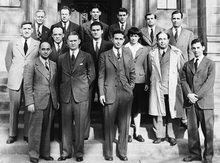Albert Wattenberg
Albert Wattenberg | |
|---|---|
University of Illinois at Urbana–Champaign | |
| Thesis | Photo-neutron sources and the energy of the photo-neutrons (1947) |
| Doctoral advisor | Walter Zinn |
Albert Wattenberg (April 13, 1917 – June 27, 2007), was an American
Early life
Albert Wattenberg was born in
In 1939, Wattenberg joined
Manhattan Project

Arthur Compton concentrated the teams involved in plutonium and nuclear reactor research at Columbia University, Princeton University, the University of Chicago at the Manhattan Project's Metallurgical Laboratory at the University of Chicago in early 1942.[6] There, Wattenberg built and maintained detectors and neutron sources. Indeed, after 1943, he built and maintained all the radium and beryllium neutron sources used by the entire Manhattan Project. He assisted in the construction of Chicago Pile-1, the world's first artificial nuclear reactor, and was one of those present on December 2, 1942, when it achieved criticality.[5] Afterwards, Eugene Wigner opened a bottle of Chianti to celebrate, which those present drank from paper cups.[7][8][9] The bottle was signed by those present, and kept as a souvenir by Wattenberg.[8][10] In 1980, he donated it to the Argonne National Laboratory.[5]
In 1943, Wattenberg married Shirley Hier,
After Fermi left the Metallurgical Laboratory for the
Later life

With the war over, Wattenberg returned to his studies,[2] completing his PhD at the University of Chicago under the supervision of Walter Zinn. He wrote his thesis on "Photo-neutron sources and the energy of the photo-neutrons", and earned his doctorate in 1947.[13] Rather than work in academia, he chose to join Fermi at the Argonne National Laboratory, where he helped design and build nuclear reactors. Wattenberg became director of Argonne's Physics Division in 1949.[5] He did not agree with Zinn's decision, as director of the laboratory, to concentrate on reactor design rather than basic research.[14]
By 1950, the rise of
In retirement, Wattenberg became involved with the American Physical Society's Forum of the History of Physics, as a councillor, secretary-treasurer, and editor of the newsletter. He contributed articles to the Bulletin of the Atomic Scientists about the beginnings of the
Wattenberg's wife Shirley died in 1989. In 1992, he married Alice Wyers von Neumann,[1] a social worker.[15] He died at Clark-Lindsey Village in Urbana, Illinois, on June 27, 2007. He was survived by his wife Alice, daughters Beth, Jill and Nina, and his brother Lee.[1]
Notes and references
- ^ a b c d e f g h i "Albert Wattenberg, 90, Pioneered Nuclear Energy". Vinyard Gazette. July 5, 2007. Retrieved December 4, 2015.
- ^ .
- ^ "Albert Wattenberg in the 1940 Census". Ancestry.com. Retrieved December 4, 2015.
- ^ Martindec, Douglas (December 18, 2014). "Lee W. Wattenberg, Who Saw Cancer Fighters in Foods, Dies at 92". The New York Times. Retrieved December 4, 2015.
- ^ a b c d e f g h "Albert Wattenberg". Department of Physics at the University of Illinois at Urbana–Champaign. Retrieved December 4, 2015.
- ^ Rhodes 1986, pp. 399–400.
- ^ Anderson 1975, p. 95.
- ^ ISBN 978-1-4899-6313-0.
- ISBN 978-1-58729-750-2.
- ^ Wattenberg 1975, p. 118.
- ^ "Atomic Bomb: Decision – Szilard Petition version 1, July 3, 1945". Gene Dannen. Retrieved 5 December 2015.
- ^ Infield, Tom (December 2, 1992). "The Chain Reaction In Chicago That Shook The World In The Race To Build The Bomb, The U.s. Had An Advantage. It Had Some Of The Best Minds From Around The World". The Philadelphia Inquirer. Retrieved 5 December 2015.
- OCLC 21318709. Retrieved December 4, 2015.
- ^ Holl, Hewlett & Harris 1997, p. 87.
- The News Gazette. Retrieved December 4, 2015.
Bibliography
- OCLC 1982052.
- Holl, Jack M.; ISBN 978-0-252-02341-5.
- ISBN 0-671-44133-7.
- Wattenberg, Albert (1975). "Present at Creation". In Wilson, Jane (ed.). All In Our Time: The Reminiscences of Twelve Nuclear Pioneers. Chicago: Bulletin of the Atomic Scientists. pp. 105–123. OCLC 1982052.
